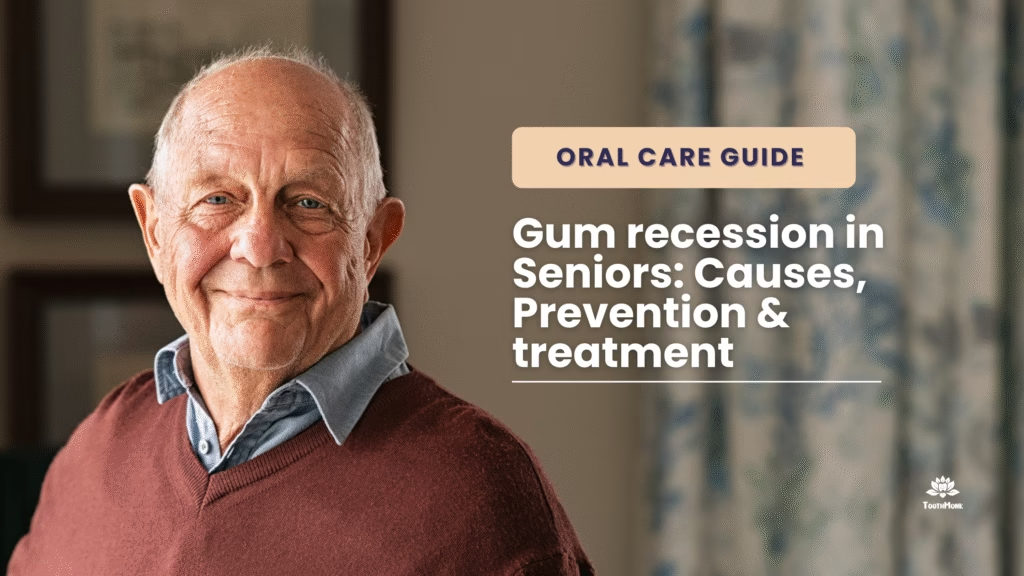
Understanding Gum Recession: A Common Concern in Aging Smiles
As we grow older, our bodies go through a host of changes, and our oral health is no exception. Among the most common yet often overlooked dental issues in seniors is gum recession. This condition not only affects the aesthetics of a smile but can also lead to serious oral health complications if left untreated. In this blog, we’ll explore the science behind gum recession, its causes in older adults, and how it can be prevented and treated effectively.
What Is Gum Recession?
Gum recession occurs when the gum tissue that surrounds the teeth pulls back or wears away, exposing more of the tooth or the tooth’s root. This creates gaps or “pockets” where plaque and bacteria can accumulate, potentially leading to further gum disease and tooth loss.
Why Is Gum Recession More Common in Seniors?
Several age-related factors make older adults more prone to gum recession:
1. Cumulative Wear and Tear
Over the decades, constant brushing, chewing, and even grinding can wear down gum tissues. Aggressive brushing with hard-bristled toothbrushes, in particular, can erode the gum line.
2. Periodontal Disease
Gum disease (gingivitis and periodontitis) is a major cause of gum recession. As we age, the immune system weakens, making it harder to fight off infections, and allowing bacteria in plaque to cause inflammation and destruction of gum tissues and supporting bone.
3. Dry Mouth (Xerostomia)
Seniors often take medications that cause dry mouth. Saliva is essential for neutralizing acids and washing away bacteria; without it, the mouth becomes more vulnerable to infections and gum deterioration.
4. Hormonal Changes and Medical Conditions
Post-menopausal women may experience hormonal changes that make gums more sensitive and vulnerable to recession. Chronic conditions like diabetes can also compromise gum health.
5. Poorly Fitting Dental Appliances
Dentures or partials that don’t fit properly can irritate the gums and contribute to recession over time.
The Science Behind Gum Recession
Gum tissue is made up of connective tissue and epithelial cells that attach to the surface of the tooth. When this tissue is exposed to chronic irritation or inflammation (from bacteria, force, or trauma), it begins to break down. As the underlying alveolar bone supporting the teeth is also resorbed with age or disease, the gums lose their structure and begin to pull back.
Once the root surface is exposed, it’s not protected by enamel like the crown of the tooth, making it highly susceptible to decay and sensitivity.
Signs of Gum Recession
- Sensitive teeth (especially to cold or heat)
- Visible tooth roots
- Longer-looking teeth
- Bleeding after brushing or flossing
- Loose teeth or shifting of bite
- Bad breath or taste in mouth
Prevention: What Seniors Can Do
1. Gentle Oral Care Practices
Switch to a soft-bristled toothbrush and brush using gentle circular motions. Avoid vigorous horizontal scrubbing.
2. Use Desensitizing or Gum-Specific Toothpastes
Formulas designed for gum health or sensitivity can help protect the exposed roots and reduce discomfort.
3. Routine Dental Visits
Regular checkups help catch gum recession early and monitor any changes in gum health.
4. Fluoride Treatments & Mouthwashes
Fluoride strengthens the enamel and root surfaces, while antimicrobial mouthwashes reduce bacterial load.
5. Quit Smoking
Smoking constricts blood vessels in the gums, reducing their ability to heal and increasing the risk of infection and tissue loss.
6. Stay Hydrated and Manage Dry Mouth
Drink plenty of water and consider sugar-free lozenges or saliva substitutes if dry mouth is an issue.
Treatment Options for Gum Recession
1. Deep Cleaning (Scaling and Root Planing)
This non-surgical procedure removes plaque and tartar from below the gumline and smooths the root surfaces to promote gum reattachment.
2. Gum Graft Surgery
Tissue is taken from another area of the mouth (usually the palate) or a donor source and grafted onto the receded area to cover exposed roots and reinforce gum tissue.
3. Pinhole Surgical Technique (PST)
A minimally invasive procedure where a small hole is made in the gum tissue and special instruments are used to reposition the gums over the exposed roots.
4. Composite Restoration
Tooth-colored materials may be used to cover the exposed root surface and improve aesthetics and sensitivity.
Protecting Smiles at Every Age
Gum recession is not an inevitable part of aging, it can be prevented and managed with the right care. For seniors, maintaining healthy gums is crucial not only for oral function but for overall health and confidence. If you or a loved one notice signs of gum recession, don’t ignore them. Speak to your dentist, adopt a gum-friendly oral care routine, and take proactive steps to protect your smile for the years to come.
Because at Toothmonk, we believe every smile deserves lifelong care.
For more clinical and research-backed information on gum disease and treatments, refer to the American Dental Association’s section on Gum Disease: https://www.ada.org/resources/research/science-and-research-institute/oral-health-topics/gum-disease. Staying informed is the first step toward maintaining a healthy smile.
We’ve created a Complete Guide to Gum Care with expert-backed advice on how to build a protective oral care routine, especially for seniors. It’s packed with tips, product recommendations, and lifestyle changes that promote gum health at every age.
